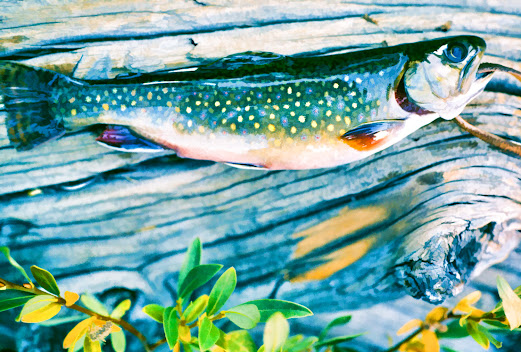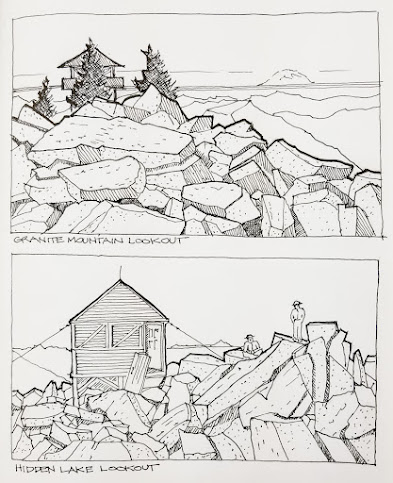It seems to me that the sport of watercolor is much like fly fishing in that there is a rich heritage, with many superb talents to inspire us all. And, in contemporary times the assortment of materials has exploded in both breadth and depth, and technical advances that make for a most confusing array of choices. And the demanding ‘how of it’ is like learning to fly fish, from reading the water (an apt comparison), identifying where trout are holding, and what they’re eating, selecting the pattern, and making a deft presentation. Each requires attention, patience, and willingness to take risks. And both are water-based sports, a fluid ephemeral medium, always changing. And as we change with it, in those moments, we may experience the possibility of transcendence.
Wednesday, February 23, 2022
The Sport of Watercolor
It seems to me that the sport of watercolor is much like fly fishing in that there is a rich heritage, with many superb talents to inspire us all. And, in contemporary times the assortment of materials has exploded in both breadth and depth, and technical advances that make for a most confusing array of choices. And the demanding ‘how of it’ is like learning to fly fish, from reading the water (an apt comparison), identifying where trout are holding, and what they’re eating, selecting the pattern, and making a deft presentation. Each requires attention, patience, and willingness to take risks. And both are water-based sports, a fluid ephemeral medium, always changing. And as we change with it, in those moments, we may experience the possibility of transcendence.
Friday, February 11, 2022
A Way of Seeing
Gestalt
or nuance? When we look at a photograph, I sense that we focus more on the gestalt,
but when we sketch and paint, we are inevitably drawn towards more considered scrutiny
of form, texture, color, light and shadow, and the relationship of objects. It’s
my experience (of course, echoed by others), that painting becomes a way of
seeing that deepens the perceptions and experiences of the artist. This quick pen
and wash study is my first in my new Stillman & Birn Zeta notebook. And
through the process, I saw the lookout scene with new eyes. I like the way the
paper takes the pigments.
Having recently resumed sketching and watercolor art after a long, long hiatus I was, at first, cautious, afraid actually, of using the bush and water-based pigments to do anything beyond wash exercises. So, I thought, it was better to get my hand back in through sketching. Yes, that would be a way to wade into the waters of a spontaneous medium that celebrates boldness, a medium intolerant of fools. What to sketch? Why not cairns. Yes, cairns. They are everywhere in the Cascades and while some disdain their presence as they violate to ethics of ‘leave no trace,’ I often find them stunningly beautiful.
The cairn at the ridgeline at Maple Pass points north towards the jagged peaks of the North Cascades. Even though secured to the earth through force of gravity, they are, nonetheless, ephemeral as they do get knocked over, and added to.
The big cairn on the summit of Alta Mountain anchors a high point in the Alpine Lakes Wilderness, a place to pause and gaze. And we did, resting, snacking, and telling mountain stories as our eyes looked north.
Other
favorite mountain destinations are the summits that host the historic fire
lookouts. I have only hiked to 13 of Washington State’s over 90 fire
lookouts. But they have all been spectacular. Of course, I have my favorites. I
have been to Granite Mountain Lookout 11 times. As a subject, there is a lot to
recommend for both photography and sketching. I have posted numerous spherical
panoramas of it at my gallery at 360Cities.net. And now, one of this
recent pair in pen and ink. It’s a little study and I had fun with it. However,
I find the boulder fields difficult. It’s not yet easy to make a fast and loose
rendition. Perhaps those with fewer boulders, like Alpine Lookout, Shriner Peak, and Kelly Butte will be more accommodating.
It soon
became evident that I would have no lack of subject material, even in the dead
of winter, as my deep library of mountain images would provide inspiration for
interpretation.
Friday, February 4, 2022
Don't Do It!
If there
was ever any universal advice offered to first-time authors who wanted to
self-publish their new book, it would be, “Don’t even think of designing your
own cover. Hire a professional.” Did I listen? No, of course not. Last
February, after my first draft was complete, I turned my attention to covers.
That would be fun, would it not? Fortunately, I was a decent photographer and
had a background in design. So, this should be easy, right?
My early
working title was “Beers in the Stream,” but as time went on, I realized that
it said nothing about the scope of the book and the story arc, except in a most
peripheral way, that would surely confuse everyone, except me. So, that title
simply landed on the chapter about our adventure to Lake Ingalls and the
subsequent classic ascent of the North Ridge of Mt. Stuart. Unfortunately, the
photo of the beers in the stream doesn’t even show up in the book.
So, I scanned my library of photographic images, both vintage and contemporary, and selected over forty that I thought showed cover potential. I cropped them and assembled them in a photo gallery to mull over. After paring it down to a dozen, I mocked them up, with half a dozen potential titles, more subtitles, and with an array of fonts. The permutations counted well over a hundred mock-ups. And even then, I wasn’t happy with the fonts.
At first, I loved the look of Charlemagne Standard, a font designed in 1989 by Carol Twombly, with basic forms modeled after those used in classical Roman engravings. But after further examination, it seemed that fancy serif fonts in color weren’t going to provide the requisite visual impact when the cover was reduced to thumbnail size on a bookseller’s website. And, it turns out that the choice of serif versus sans serif has a lot to do with the genre of your subject. No, I am not joking.
So, I went to phase two, mocking up the best contenders to pick a final font. It turns out that a bold sans serif white font has the most visual impact for book covers, at least in my chosen book genre. After trying many, I settled not on Helvetica, which I had known since my days in college as an architecture student, but on one I had never heard of before. Its name is Mesmerize. And it mesmerized me. From the moment I composed it as text over my cover photos in Photoshop, I knew it was the one. I breathed a sign of relief. Another hurdle crossed.
And from
those new cover candidates, I finally picked my title, Banquet of the Infinite. The final decision on the subtitle would take even longer. While I
fell in love with my night sky Milky Way photo with Granite Mountain Lookout in the foreground, I
wondered if potential readers might equate the title with an exploration of the
universe. No, not quite right. Next.
This early self-portrait was shot with the self-timer with my Nikon F film camera looking out at the Sierra peaks from inside Omnipotent #13, back in 1973. And while I like it, I knew it wasn’t the cover shot. It’s a crop from a horizontal image, so somewhat compromised, and I was concerned that it might be confusing, and perhaps a little busy visually. Next.
This image of me hiking up a creek bed in the Sierra appealed to me but then again, most of the memoir stories take place in the Pacific Northwest. Again, I was concerned that potential readers might be too 'concrete literal' in their expectations based on their perception of the image. Next.
I love this vintage image that I took in 1977. And, it appears in the book chapter titled “Warbonnet and Wolf’s Head.” Diane standing on the boulder, looking into the distance, under the prominent feathered crest of Warbonnet Peak, has that Maxfield Parrish ‘girls on rocks’ thing going on, and I think it’s incredibly romantic. It is, however, a bit visually busy with the graphics and it might not make sense to a potential reader when seen in an online thumbnail image on a bookseller’s site. Let’s see if I can do better. Next.
I took this shot of Dragontail Peak while pausing during the trudge up Aasgard Pass with David Stevenson in 2019. I love the drama with the fractured granite and golden larches. And we’re back in Washington. But again, is it too busy? Next.
Later, that same day, as the temperature plummeted and the gray rolled in, the image seems even more ethereal, and dare I say, infinite. Not bad, but is it the one, the one that will draw in a potential reader? And again, is it too busy? Next.
And now, simpler with more diffused light and more contrast and clarity with the title font. But is it both intriguing and welcoming? Or is it too gothic and dour? Next.
Finally.
It’s a clear, crisp, simple image of Lake Ingalls with Mt. Stuart both on the
horizon and in reflection. A simple grab shot from a solo hike during the 2020 pandemic turned out to be a pleasant surprise. I think it speaks to the title
and is both intriguing and welcoming. Done!
My engaging mountain memoir, Banquet of the Infinite, is now available as an
eBook on Amazon, Barnes & Noble, and Kobo.
Lighthouse
The tumult and roar of thrashing, crashing waves shook our fragile craft. The cold pelting night rains send chills through our bodies, and t...

Beers in the Stream
-
We were young, smart, and confident. Adventurous mountaineers determined to make our mark. It would not be easy, but the will to act was per...
-
Our backyard crows are a tight-knit tribe and occasionally part of a considerable murder. And we are not members. Okay, Diane gives them see...
-
When it comes to hiking destinations, lakes or peaks, I usually prefer peaks. I like scrambling, or climbing to their summits for the opport...



















